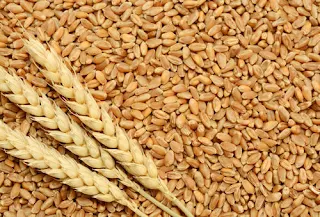Wheat Oneliner- Agronomy Important Q & A For All Competitive Exams
1.Origin of wheat: South West Asia
2.Botanical Name of Wheat: Triticum astivum
( Bread Wheat)
3.Family of wheat: Gramineae/Poaceae
4.Chromosome number of wheat: 2n=42
5.Basic chromosome number of wheat:
7
6.Wheat is a C3, Self Pollinated, long day plant.
7. Wheat is Cool and moist
weather loving crop.
8. Ph for wheat cultivation: 6 to 7.5
9.Wheat is a Staple food of world.
10.Wheat is known as King of cereals.
11.Wheat and mustard
intercropping ratio 9:1
12.Harvesting index of wheat: 40-50%
13.Spacing for wheat
sowing: 22.5 x 10 cm
14.Germination type in wheat: Hypogeal.
15.Fruit type of wheat: Caryopsis.
16.Inflorescence of wheat: Head/Ear/Spike.
17.Zigzag axis called as Rachis.
18.Spikelets are composed
flower called Florats.
19.Water requirement in wheat: 500- 600mm.
20.Number of irrigation required in wheat: 6.
21.IW/CPE ratio of wheat:0.90
22. Wheat storage moisture
percentage : 10-12%
23. Moisture content at harvesting stage in wheat: 25-30%
24.Shelling percentage of wheat : 60%
25.Triticale is a man made cereal
which is cross of Wheat
x Rye ( by Rimpu,Swidon,1875).
26.Gene found in wheat – Rht-1,2.
27. First variety
of triticale is DT-46.
28.
Larma rojo all three rust of wheat resistant variety.
29.
Seed multiplication ratio of wheat:
1:20
30.
Goojo method is used for production of hybrid seed in wheat.
31. Indian institute
of wheat and barley research, Karnal, Haryana
32. Seed rate for wheat sowing-
- Dibbling method: 25-30 kg/ha.
- Normal sowing:
100 kg/ha.
- Late sowing: 125 kg/ha.
33.
Temperature for wheat cultivation-
- Mimimum/base : 4⁰C
- Optimum : 20-22⁰C
- Maximum : 32⁰C
34.
Temperature for vegetative stage is 16-22ºC.
Temperature above 22ºC decreases the plant height.35.Sowing depth of wheat: 3-4cm
36.Tall wheat sowing depth: 8-9 cm
37.Test weight of wheat is 40 gm and Test Weight of Phalaris Minor 2 gm.
38.Critical stage for irrigation is CRI after 21 DAS. Discovered by B.L. Bhardwaj.
39.Objectional weed of wheat: Convolvulus arvensis.
40.Absolute weed of wheat: Chenopodium album (Bathua).
41.Norin- 10 is dwarfing
gene in wheat which is discovered by
Dr. N.E. Boulaug in 1962
42.Phalaris minor is a mimicary weed of wheat. Earlier controlled by isoproturon, now a days it is controlled by solfosulforen.
43.Common herbicide for wheat is 2, 4-D.
44.Bio-fertilizer use in wheat: Azotobacter (Non-symbiotically)
45.Triticum aestivum (2n=42):
Mexican dwarf wheat, 87% area covered by
T. aestivum, evolved by Dr. N.E. Borlaug. It is also called as Bread wheat. Most suited for chapati and bakery.
It is cultivated throughout India
46.T. vulgare (2n=42): tall wheat for
rainfed condition, typical wheat for alluvial soil.
47.T. durum (2n=28): Marconi wheat,
best for drought condition, used for suji purpose,
covered 12% of total wheat. It is best suited for preparation of noodles, vermicelli, etc.
48.T. dicocum (2n=28): emmer wheat called as winter / spring wheat, used for uppumav purpose, mainly grown in
south india, only 1 % covered of total wheat area.
49.T. spherococum (2n=14) : Indian
dwarf wheat
50.T. monococum (2n=14):
Einkon wheat
51.Seminal roots of wheat:temporary and responsible for nourishment to plant in early stage.
52.Crown roots of wheat: Permanent and appeared after tillering stage(20-22 DAS)
53.Critical phases
of wheat for irrigation are:CRI: 20-25
DAS
54.Second most critical
stage: Flowering
55.Third important stage: Jointing and Milk stages
56.Problematic mono-cot weeds of wheat are: Phalaris minor – (Canary
grass), Avena fatua
(Wild oat), Polypogan
monspliensis.





